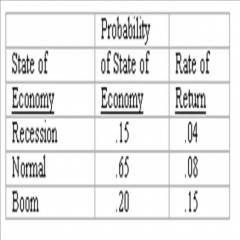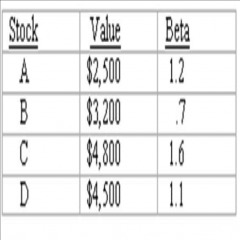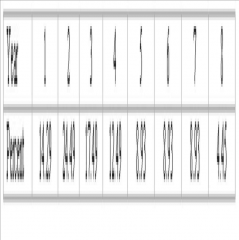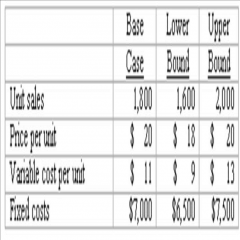![]()
![]()
![]()
Use LEFT and RIGHT arrow keys to navigate between flashcards;
Use UP and DOWN arrow keys to flip the card;
H to show hint;
A reads text to speech;
57 Cards in this Set
- Front
- Back

The stock of MansfieldMotors is expected to produce the following returns given the various states ofthe economy. What is the expected return on this stock?
A. 8.4 percent B. 8.8 percent C. 9.1 percent D. 9.5 percent E. 9.7 percent |
(15% x 4%) + (65% x 8%) + (20% x 15%)
B. 8.8 percent |
|

Given the followinginformation, what is the variance for this stock?
A. .004872 B. .004900 C. .005112 D. .005264 E. .005329 |
Expected Return (20% x 17%) + (70% x 9%) + (10% x -11%) = 8.6% Standard Deviation 20% x (17% - 8.6%)^2 +70% (9% - 8.6%)^2 + 10%(-11% - 8.6%)^2 D. .005264 |
|
|
You own a portfolioconsisting of the securities shown below. The expected return for the next yearis also provided. What is the expected return on the portfolio? A. -1.12 percent B. 1.34 percent C. 1.42 percent D. 1.46 percent E. 1.53 percent |
J = 400 x $63 =25200 K = 2600 L = 30400 M = 7200 ------------------ 65,400 (38.5% x 9%) + (4% x 11%) + (46.5% + -12%) + (11%x 5%) A. -1.12 percent |
|

You have a portfoliocomprised of the following. What is your portfolio beta? A. 1.19 B. 1.27 C. 1.34 D. 1.36 E. 1.41 |
16.7% 21.3% 32% 30% (16.7% x 1.2) + (21.3% x 0.7) + (32% x 1.6) + (30x 1.1) A. 1.19 |
|
|
Stock A has an expected return of 12 percent and a beta of1.2. Stock B has an expected return of 9 percent and a beta of .8. Both stockshave the same reward-to-risk ratio. What is the risk-free rate? A. 2.5 percent B. 3.0 percent C. 3.5 percent D. 4.0 percent E. 4.5 percent |
(12% - Rt) / 1.2 = (9% - Rt) /0.8 B. 3.0 percent |
|
|
A stock has a beta of 1.12 and an expected return of 11.6percent. The risk-free rate is 4.2 percent. What is the slope of the securitymarket line? A. 5.45 percent B. 6.61 percent C. 7.40 percent D. 8.28 percent E. 10.32 percent |
(11.6% - 4.2%) / 1.12 = Reward/Risk B. 6.61 percent |
|
|
The stock of Delta Electrical, Inc., has a beta of .98. Themarket risk premium is 9 percent and the risk-free rate is 4.4 percent. What isthe expected return on this stock? A. 8.91 percent B. 9.43 percent C. 10.67 percent D. 11.25 percent E. 13.22 percent |
(4.4% - 0.98) x 9% E. 13.22 percent |
|
|
Last week, Baxter Industries paid their annual dividend of$1.34 on their common stock. The company predicts that the dividend will increaseby 3.5 percent each year indefinitely. What is the firm's cost of equity if thestock is selling for $43 a share? A. 4.89 percent B. 6.62 percent C. 6.73 percent D. 7.12 percent E. 7.38 percent |
R = (D1/P1) + g =[(1.34 x 3.5%) + 1.34) / 43] +3.5% C. 6.73 percent |
|
|
Nelson Enterprises just paid an annual dividend of $1.56 pershare. This dividend is expected to increase by 3 percent annually. Currently,the firm has a beta of 1.13 and a stock price of $28 a share. The risk-freerate is 3 percent and the market rate of return is 10.5 percent. What is yourbest estimate of Nelson's cost of equity? A. 8.74 percent B. 9.38 percent C. 9.72 percent D. 10.11 percent E. 11.48 percent |
R1 = [[1.56 x (1+3%) ] / 28 ]+3%R2 = 3%+1.13 (10.5% - 3%) (R1+R2)/2 D. 10.11 percent |
|
|
Market Basket, Inc., has 125,000 shares of common stockoutstanding at a price of $43 a share. They also have 25,000 shares ofpreferred stock outstanding at a price of $55 a share. There are 10,000, 8percent bonds outstanding that are priced at 99 percent of face value. Thebonds mature in 16 years and pay interest semiannually. What is the capitalstructure weight of the preferred stock? A. 7.68 percent B. 8.26 percent C. 9.98 percent D. 13.67 percent E. 17.77 percent |
E= 125000 x 43 P = 25000 x 55 D = 10,000 x 99% x 1000 P / (E + P + D) B. 8.26 percent |
|
|
The Bigelow Company has acost of equity of 12 percent, a pre-tax cost of debt of 7 percent, and a taxrate of 35 percent. What is the firm's weighted average cost of capital if thedebt-equity ratio is .60? A. 6.58 percent B. 9.21 percent C. 10.01 percent D. 10.13 percent E. 11.11 percent |
D/E = 0.6/1 D +E = 1.6 WACC = [12% x (1/1.6)] + [7% x (0.6/1.6)] x(1-35%) B. 9.21 percent |
|
|
Black and White has a cost of equity of 11 percent and apre-tax cost of debt of 8.5 percent. The firm's target weighted average cost ofcapital is 9 percent and its tax rate is 35 percent. What is the firm's targetdebt-equity ratio? A. 48.29 B. 51.13 C. 55.72 D. 57.56 E. 62.03 |
D/E = X/1 D=X E=1D+E = 1+X 9% = 11% x (1/1+x) + 8.5% x (x/1+x) x (1-35%) D. 57.56 |
|
|
Bruno's is an all-equity firm with 20,000 shares of stockoutstanding. The stock has a beta of 1.3 and a standard deviation of 8 percent.The market risk premium is 6.5 percent and the risk-free rate of return is 2percent. The company is considering a project which it believes has 20 percentmore systematic risk than the firm's current operations. What should therequired rate of return be for this project? A. 11.78 percent B. 12.14 percent C. 12.39 percent D. 12.54 percent E. 12.78 percent |
2+ 1.3 x (1+20%) x 6.5% Beta = 1.3 x 1+20% B. 12.14 percent |
|

A project requires $120,000 of equipment whichis classified as 7-year property. What is the depreciation expense in year 3given the following MACRS depreciation allowance percentages? A. $13,583 B. $16,583 C. $18,618 D. $18,997 E. $20,988 |
120,000 X 17.49 % E. $20,988 |
|

You are analyzing a projectand have developed the following estimates. The depreciation is $2,500 a yearand the tax rate is 35 percent. What is the base case operating cash flow? A. $4,520 B. $5,984 C. $6,855 D. $7,767 E. $7,913 |
1800 x $20 - 1800 x $11 - 7000 - 2500 ----------------------------------- EBIT = 6700 - Tax 2345 OCF = 6700 + 2500 - 2345 C. $6,855 |
|
|
A pro forma financial statement is a financial statementwhich: A. is computed using common-size percentages. B. compares the performance of a firm over the past five years. C. compares the actual performance of a firm to its budget. D. projects future years' operations. E. reflects the difference between a firm's net income with and withoutdebt financing.
|
D
|
|
|
The analysis of the effects that what-if questions have on aproject is referred to as _____ analysis. A. sensitivity B. erosion C. cost reduction D. scenario E. benefit
|
D
|
|
|
The analysis of the effect that a single variable has on thenet present value of a project is called _____ analysis. A. sensitivity B. erosion C. cost reduction D. scenario E. benefit
|
A
|
|
|
The net working capital invested in a project isgenerally: A. a sunk cost. B. an opportunity cost. C. recouped in the first year of the project. D. recouped at the end of the project. E. depreciated to a zero balance over the life of the project.
|
D
|
|
|
Operating cash flow is equal to: A. net income plus depreciation minus taxes. B. net income minus depreciation minus interest expense. C. EBIT minus taxes. D. EBIT minus taxes minus depreciation. E. EBIT minus taxes plus depreciation.
|
E
|
|
|
Which of the following are examples of managerial options? I. changing the price of a productII. discontinuing the production of a productIII. waiting for a period of time before commencing a projectIV. changing the production process by which a product is manufactured A. II only B. I and III only C. II and IV only D. I, II, and III onlyE. I, II, III, and IV
|
E
|
|
|
A firm has net income of $42,000, depreciation of $3,000,interest expense of $1,200, and taxes of $1,100. What is the firm's operatingcash flow? A. $40,200B. $43,800 C. $45,000 D. $46,200 E. $48,800
|
D
|
|
|
Lakeside Grapes is considering expanding its wine-makingoperations. They would need new equipment that costs $350,000 that would bedepreciated on a straight-line basis to a zero balance over the 5-year life ofthe project. The estimated salvage value is $62,000. The project requires$35,000 initially for net working capital, all of which will be recouped at theend of the project. The projected operating cash flow is $187,500 a year. Whatis the net present value of this project if the relevant discount rate is 15percent and the tax rate is 35 percent?A. $237,515.24 B. $240,018.12 C. $245,966.49 D. $269,655.72 E. $280,966.49
|
E
|
|
|
Risk premium is defined asthe: A. rate of return on a U.S. Treasury bill. B. required return on a security less the inflation rate. C. excess return required on a risky investment over that of a risk-freeinvestment. D. average actual return on a security minus the inflation rate. E. the nominal rate of return less the real rate of return
|
C
|
|
|
When a financial market reflects all the availableinformation in the prices of the securities the market is referred to asa(n): A. normal distribution. B. primary market. C. efficient capital market. D. delayed reaction market. E. current yield market.
|
C
|
|
|
The hypothesis that supports the argument that any pricinginefficiencies are rare and relatively small is known as the _____hypothesis. A. capital market B. market turnover C. pricing D. efficient market E. net present value
|
D
|
|
|
Over the period of 1926 through 2004: A. long-term government bonds outperformed long-term corporate bonds. B. small-company stocks outperformed large-company stocks. C. inflation exceeded the rate of return on U. S. Treasury bills. D. U.S. Treasury bills outperformed long-term government bonds.E. large-company stocks outperformed bonds as well as small-companystocks.
|
B
|
|
|
The risk-free rate is based on the rate applicable to: A. long-term corporate bonds. B. long-term government bonds. C. short-term corporate bonds. D. U.S. Treasury bills. E. the Consumer Price Index
|
D
|
|
|
Which one of the following should you expect to have thehighest risk premium in the future? A. U.S. Treasury bills B. large-company stocks C. long-term government debt D. small-company stocks E. long-term corporate debt
|
D
|
|
|
The higher the standard deviation of a security, the _____the expected rate of return and the _____ the risk. A. lower; lower B. lower; higher C. higher; lower D. higher; higher E. more constant; more constant
|
D
|
|
|
The mean plus or minus twice the standard deviation for anormal distribution provides a probability range of _____ percent. A. 66 B. 68 C. 95 D. 97 E. 99
|
C
|
|
|
If the securities markets are only weak form efficient, thenthe price of a stock will: A. react to new information over a couple of weeks. B. react slowly to new information concerning the future outlook of thefirm. C. tend to overreact to new information concerning the future plans of thefirm. D. be based solely on historical information. E. totally reflect the true value of the firm.
|
D
|
|
|
Which one of the following supports the argument thatfinancial markets are semistrong form efficient? A. financial analysts gain a marketplace advantage by studying financialstatements B. only company insiders have a marketplace advantage C. only historical information is reflected in the market prices ofsecurities D. all information, public and private, is included in current marketpriceE. technical analysis based on price patterns provides a marketplaceadvantage
|
B
|
|
|
If the financial markets are strong form efficient,then: A. only the most talented analysts can determine the true value of asecurity.B. only company insiders have a marketplace advantage.C. technical analysis provides the best tool to use to gain a marketplaceadvantage. D. no one person has an advantage in the marketplace. E. the only true advantage in the marketplace is having insiderinformation.
|
D
|
|
|
One year ago, you purchased 100 shares of stock for $38 ashare. The stock pays dividends of $.20 per share per quarter. Today, you soldyour shares for $40.50 a share. What is your total dollar return on thisinvestment? A. $270 B. $285 C. $315 D. $330 E. $340
|
D
|
|
|
The Stone Ware Company pays a constant dividend. Last year,the dividend yield was 2.4 percent when the stock was selling for $20 a share.What must the stock price be if the market currently requires a 3.2 percentdividend yield on this stock? A. $15.00 B. $15.48 C. $17.98 D. $20.00 E. $20.64
|
A
|
|
|
One year ago, Isabelle purchased 3,500 shares of RTF stockfor $133,000. Today, she sold these shares for $41.10 a share. What isIsabelle's total return on this investment if the dividend yield is 4.9percent? A. 4.90 percent B. 6.26 percent C. 8.16 percent D. 11.90 percent E. 13.06 percent
|
E
|
|
|
Last year, Kurt invested $1,000 in ABC stock, $1,000 inlong-term government bonds, and $1,000 in U.S. Treasury bills. Over the courseof the year, he earned returns of 10.3 percent, 8.8 percent, and 4.3 percent,respectively. What is the risk premium that Kurt received on his ABC stockinvestment? A. 1.50 percent B. 3.00 percent C. 4.50 percent D. 6.00 percent E. 10.5 percent
|
D
|
|
|
Over the past five years, a stock provided annual returns of12.6 percent, 5.8 percent, 7.9 percent, -11.2 percent and -2.4 percent. What isthe variance of these returns? A. .0067 B. .0078 C. .0088 D. .0094 E. .0101
|
C
|
|
|
A bond has an average return of 6.8 percent and a standarddeviation of 4.6 percent. What range of returns would you expect to see 68percent of the time? A. 2.2 percent to 11.4 percent B. 4.6 percent to 11.4 percent C. 4.6 percent to 22.8 percent D. 11.4 percent to 22.8 percent E. 11.4 percent to 16.0 percent
|
A
|
|
|
A bond has an average return of 6.8 percent and a standarddeviation of 4.6 percent. What range of returns would you expect to see 68percent of the time? A. 2.2 percent to 11.4 percentB. 4.6 percent to 11.4 percent C. 4.6 percent to 22.8 percentD. 11.4 percent to 22.8 percent E. 11.4 percent to 16.0 percent
|
C
|
|
|
Your portfolio has provided you with returns of 26.3percent, 19.8 percent, -4.6 percent, and 7.9 percent over the past four years,respectively. What is the geometric average return? A. 8.06 percent B. 9.27 percent C. 10.25 percent D. 11.71 percent E. 12.35 percent
|
D
|
|
|
The risk associated withthe overall market is referred to as _____ risk
|
systematic
|
|
|
Unsystematic risk isdefined as the risk:
|
that affects a small number of securities.
|
|
|
Investing in a number ofdiffering assets to eliminate some of the risk is referred to as the principleof:
|
diversification.
|
|
|
Which one of the followingis the best example of an event related to an expected return? A. an announcement that a firm will meet itssales projections B. a GDP growth rate that surpassed predictions C. a sudden increase in the inflation rate D. a news release that a firm is going to be acquired at a premium E. a market decline due to increased tensions in the world
|
A. an announcement that a firm will meet itssales projections
|
|
|
The risk premium for asecurity is based on the _____ associated with the security.
|
systematic risk
|
|
|
A portfolio that isadequately diversified should produce a return which:
|
lies at a point on the security market line given theportfolio's beta.
|
|
|
The beta of a risk-freesecurity is _____ and the beta of the overall market is:
|
0; 1
|
|
|
The slope of the securitymarket line is equal to:
|
the market risk premium.
|
|
|
Based on the capital assetpricing model, a security that:
|
is over-priced will plot as a point below the securitymarket line.
|
|
|
A firm's overall cost ofcapital:
|
is the required return on the total assets of a firm.
|
|
|
In an efficient market, asecurity with a beta of .98 will have a rate of return which lies:
|
on the SML just to the left of the market return.
|
|
|
Which one of the followingwill increase the slope of the security market line (SML)?
|
an increase in the market risk premium
|
|
|
Which one of the followingrepresents the best estimate for a firm's pre-tax cost of debt?
|
the current yield-to-maturity on the firm's existingdebt
|
|
|
Which one of the followingis a correct statement regarding a firm's weighted average cost of capital(WACC)?
|
The WACC can be used as the required return for allnew projects with similar risk to that of the existing firm.
|
|
|
The cost of capital for aproject should:
|
be adjusted based on the risk of the project.
|

